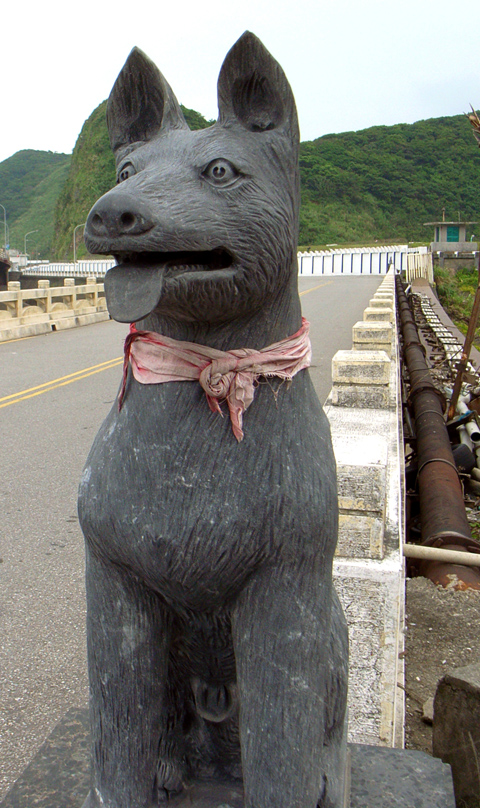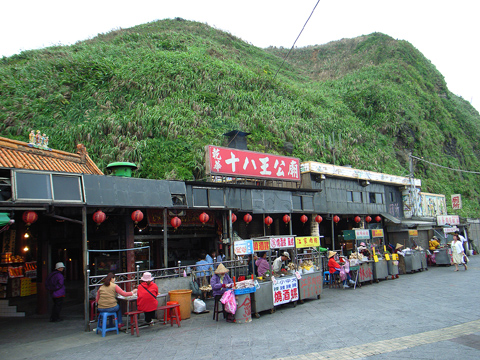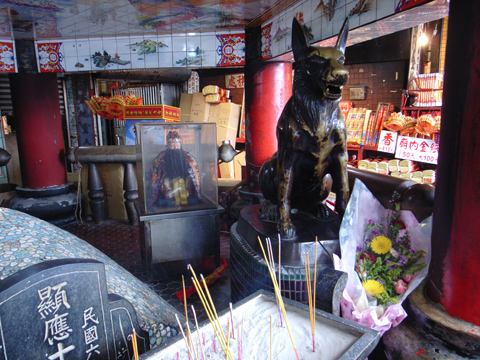The Eighteen Kings Temple (十八王公廟) was one of Taiwan’s most popular temples during the 1980s and early 1990s. Cars would line up for several kilometers along the coastal highway (No. 2) between Tamsui (淡水) and Jinshan (金山) to visit this small roadside temple — all to pay homage to 17 fishermen and a dog.
The dog is the main attraction, as well as the center of worship. The story, as told by the temple: sometime in the last century, 17 fishermen and their canine friend were crossing the Taiwan Strait when their boat capsized. The fishermen drowned, but the dog survived. When the bodies washed ashore, the locals, in keeping with customs, prepared a collective grave and ghost temple on a cliff overlooking the shore. The dog — ever loyal to its masters — jumped into the grave with the bodies and refused to leave. The dog was buried alive, and is thus called the 18th of the Eighteen Kings.
“It’s very effective here — whatever you request [of the Eighteen Kings] — you will get it,” said Cai Huang Meixue (蔡黃美雪), who works for the temple selling jinzhi (金紙), or spirit money, the gold-colored paper used as prayer offerings.

PHOTO: DAVID CHEN, TAIPEI TIMES
But no one seems to visit these days. The fun, carnival-like atmosphere for which this ocean-side temple was once renowned has faded away. Sitting on the side of a cliff, adjacent to the First Nuclear Power Plant (核一), the temple looks rundown, and the outdoor food court across the road is deserted. Now only a handful of vendors sit in front of the temple, selling rice and meat dumplings wrapped in bamboo leaves (肉粽) and braised snails (燒酒螺). A pack of stray dogs loiters about; one occasionally gets up to chase a passing car or motorcycle.
The temple’s main appeal was its unusual and weird practices. Ghosts are worshipped like gods, with wooden statues of fishermen and the dog placed in an altar. Instead of incense sticks, visitors light cigarettes and place them in the urn. Worshippers don’t normally touch images of deities, but here visitors come to stroke and rub two bronze statues of the dog. And the busiest time for worship at the temple is during the wee hours of the morning, when the ghost-spirits are said to be at their most powerful, and thus more likely to grant visitors their wishes.
Lian Tian-shen (練天申), 76, one of the managers of the temple, blames the decline of visitors on two things: the construction of a bridge that diverted main traffic away from the temple, and aggressive hawkers who sell trinkets outside the temple grounds.

PHOTO: DAVID CHEN, TAIPEI TIMES
But the decline also reflects changes in Taiwan’s economy, according to Robert Weller, professor and chairman of the anthropology department at Boston University, who has written extensively about religion and society in Taiwan.
The temple reached the height of its popularity during a period of economic uncertainty in the 1980s, according to Weller. Small, labor-intensive businesses were becoming less profitable, which increased the “feeling of competition and unpredictability of the market.”
In an email interview, he explained that “people had a lot of money but very few lines of productive investment — this was before people could invest legally on the mainland.”

PHOTO: DAVID CHEN, TAIPEI TIMES
Weller said this was an “unusual moment” for Taiwan’s economy, which “seemed like a gambling economy to people, instead of an economy that rewarded hard work or smart entrepreneurship.”
This also suited the perceived “amorality” of the temple. The ghost-spirits at Eighteen Kings Temple were reputed to grant any request, as “they did not hold to the moral codes of most gods,” he said. Thus, the temple had a reputation for visitors looking to get rich quick.
Which might also explain the temple’s former image as a popular destination for gangsters, bar hostesses, thieves and gamblers. I couldn’t help thinking of this on my visit — I sat outside the temple on a windy, cloudy afternoon, and took note of the visitors who passed through: a gang of 10 or so teenagers with dyed hair on motor scooters; two women in their forties, bags under their eyes, wearing short skirts and heels; a tired-looking middle-aged couple who stepped out of a BMW.

PHOTO: DAVID CHEN, TAIPEI TIMES
But Lian, the temple manager, told me that most visitors are normal folks — on some days, they get busloads of Japanese tourists, even Americans. (Besides, the government has cracked down on gangsters, he said.)
Weller concurs in one of his articles on the Eighteen Kings: there were simply too many visitors to peg them all as “underworld types”; many were simply ordinary people unconcerned about “issues of morality.”
Others would go just to have a good time. Patrick Fu (傅彥王貫), 35, of Taipei, remembers fondly his student days, when he and his friends would ride their motor scooters to the Eighteen Kings Temple at night for “the sense of adventure.” Fu particularly liked the night market atmosphere on the seaside. “It was exciting … the wind, the ocean, the smells,” he said. But he stopped going after the new bridge was built, as it blocked the view of the ocean. “I hate the bridge,” he said.

PHOTO: DAVID CHEN, TAIPEI TIMES
On his visits, Fu would pray at the temple — placing a lit cigarette upwards in the urn and rubbing the bronze dog — but he wasn’t so concerned with the outcome. “Actually I’m not sure if my wishes came true … it just felt better for the spirit.”
Fu, now an English teacher, recalls his last visit, more than 10 years ago. He was there with a friend, whose girlfriend had left him for another guy. The friend prayed to get her back.
“People say it [praying at the temple] works,” Fu said. He paused and thought about his friend. “But it didn’t,” he whispered with a smile.

PHOTO: DAVID CHEN, TAIPEI TIMES
For a more detailed look at the Eighteen Kings Temple, see Robert Weller’s article in Capitalism, Community, and the Rise of Amoral Cults in Taiwan in the book Asian Visions of Authority (University of Hawaii Press), and the book Resistance, Chaos and Control in China (University of Washington Press).
IF YOU GO
Getting There
» Eighteen Kings Temple is on the coastal highway (No. 2) between Tamsui and Jinshan. Take the Tamsui-Jinshan (淡水-金山) bus, which departs from the bus stop directly across from the Danshui (Tamsui) MRT Station (淡水捷運站). When you get on the bus, tell the driver you want to get off at the Eighteen Kings Temple (十八王公廟) stop. The one-way fare is NT$70. The trip should take roughly 40 minutes from the Danshui MRT Station to the temple.
A short day trip by bus along the coastal highway
» If you’re visiting the Eighteen Kings Temple (十八王公廟), there are a few pleasant spots on the way that offer nice views of Taiwan’s northern coast, all accessible by bus. All bus stops are located along the coastal highway. Take any Tamsui-Jinshan bus (淡水-金山), which comes about every 20 minutes.
» Heading back to Tamsui from the temple, stop at the Shihmen Stone Arch (石門洞), a mass of volcanic rock forming a large, natural archway. A pathway passes through the archway to the oceanside, where you can see interesting rock formations, also formed from lava flows. The rock formations are not as impressive as their sister down the highway, Yeliou (野柳), but the walk is easy and short (less than 20 minutes). Get off at the Shimentong stop (石門洞站).
» Just a few bus stops down, Cape Fukui (富貴角), the northernmost point of Taiwan proper, offers nature walks and picnic spots near the beach; there’s even a small campground. A paved footpath runs along the coastline to the tip of the cape, which is marked by a lighthouse and is near a military outpost. A leisurely walk to the lighthouse takes roughly 20 minutes.
» Near the lighthouse, a diverging path takes you to a stretch of beach below, where you can see bright-green algae formations on volcanic rock. On the other side of the cape, Fuchi Harbor (富基漁港), has a host of fresh seafood restaurants. When going to Cape Fukui, get off at the Dengtaikou stop (燈台口站), cross the short bridge, and walk about seven to 10 minutes. Make sure the bus doesn’t take you to the “official” Cape Fukui stop (富貴角站), which offers views of the cape from afar.
» The public beach at Baishawan (白沙灣), one of the nicer beaches in northern Taiwan, has improved in recent years: it feels more accessible now, thanks to a grassy area and recently built parking lot to the east. The beach area is also cleaner than before. Get off at the Baishawan stop (白沙灣站).
» The bus fare between each destination is NT$22. Travel on weekdays to avoid crowds.

Oct. 27 to Nov. 2 Over a breakfast of soymilk and fried dough costing less than NT$400, seven officials and engineers agreed on a NT$400 million plan — unaware that it would mark the beginning of Taiwan’s semiconductor empire. It was a cold February morning in 1974. Gathered at the unassuming shop were Economics minister Sun Yun-hsuan (孫運璿), director-general of Transportation and Communications Kao Yu-shu (高玉樹), Industrial Technology Research Institute (ITRI) president Wang Chao-chen (王兆振), Telecommunications Laboratories director Kang Pao-huang (康寶煌), Executive Yuan secretary-general Fei Hua (費驊), director-general of Telecommunications Fang Hsien-chi (方賢齊) and Radio Corporation of America (RCA) Laboratories director Pan

President William Lai (賴清德) has championed Taiwan as an “AI Island” — an artificial intelligence (AI) hub powering the global tech economy. But without major shifts in talent, funding and strategic direction, this vision risks becoming a static fortress: indispensable, yet immobile and vulnerable. It’s time to reframe Taiwan’s ambition. Time to move from a resource-rich AI island to an AI Armada. Why change metaphors? Because choosing the right metaphor shapes both understanding and strategy. The “AI Island” frames our national ambition as a static fortress that, while valuable, is still vulnerable and reactive. Shifting our metaphor to an “AI Armada”

The older you get, and the more obsessed with your health, the more it feels as if life comes down to numbers: how many more years you can expect; your lean body mass; your percentage of visceral fat; how dense your bones are; how many kilos you can squat; how long you can deadhang; how often you still do it; your levels of LDL and HDL cholesterol; your resting heart rate; your overnight blood oxygen level; how quickly you can run; how many steps you do in a day; how many hours you sleep; how fast you are shrinking; how

“‘Medicine and civilization’ were two of the main themes that the Japanese colonial government repeatedly used to persuade Taiwanese to accept colonization,” wrote academic Liu Shi-yung (劉士永) in a chapter on public health under the Japanese. The new government led by Goto Shimpei viewed Taiwan and the Taiwanese as unsanitary, sources of infection and disease, in need of a civilized hand. Taiwan’s location in the tropics was emphasized, making it an exotic site distant from Japan, requiring the introduction of modern ideas of governance and disease control. The Japanese made great progress in battling disease. Malaria was reduced. Dengue was